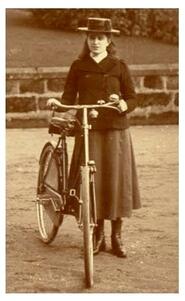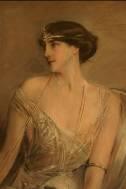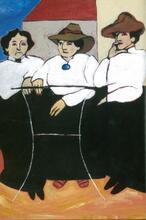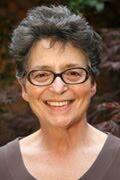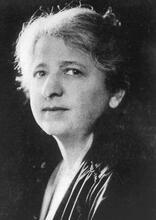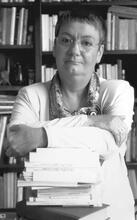Vera Frances Salomons
Vera Salomons belonged to the interconnected network of Anglo-Jewish families known as “the Cousinhood.” An elusive figure, she is best remembered for founding and funding the L.A. Mayer Museum of Islamic Art in Jerusalem. This was the culmination of a longstanding philanthropic commitment to Jewish life in what would become the State of Israel. Wealthy enough to ignore the gendered norms that governed international Jewish activism, Vera Salomons chose through her philanthropy to remember those dear to her: L.A. Mayer, and her family, to whom she dedicated a small museum in their former home near Tunbridge Wells, in Kent, England.
A Daughter of the Cousinhood
Born in London on October 31, 1888, to David Lionel Salomons (1851-1925) and Laura Julia de Stern (1855-1935), Vera Frances Salomons belonged to the interconnected network of Anglo-Jewish families known as “the Cousinhood.” She was closely related to key figures in the campaign for Jewish civil rights—above all, her great-uncle, Sir David Salomons MP (1797-1873). This David Salomons was childless and made Vera’s father his heir. The second Sir David Salomons was a scientist and inventor; Vera grew up surrounded by drills, lathes, x-ray machines, photographic equipment, and scientific paraphernalia. Broomhill, the Salomons’ country house near Tunbridge Wells, was the first in the country to use electricity for domestic purposes. The Visitors’ Book testifies to a steady stream of scientific visitors.
This was a family that valued its Jewish heritage and traditions, even as it moved away from them. Vera’s grandfather, Philip Salomons, had been a pioneering collector of Judaica. Her father was a rationalist and atheist. He rejected much that was religious about his upbringing but was married and buried under the auspices of the (Reform) West London Synagogue. He remained sufficiently connected to Judaism to ensure his children learned Hebrew: as an adult, Vera could “spout the little Hebrew [she] knew” when she first visited Palestine in 1925. Mementos preserved at their former home in Kent suggest the Salomons family retained some of Philip’s Judaica—prayer books and religious vestments—and that Vera grew to value them. As a young woman, she joined the Jewish Historical Society of England (1911-1914).
A Cosmopolitan Intellectual
Vera’s father became a pillar of provincial English society, serving as Mayor of Tunbridge Wells and High Sheriff of Kent. Her world was more cosmopolitan than that implies. Vera’s maternal grandfather Hermann de Stern (1815-1887) led the London office of Stern Brothers bank, which boasted branches (and family members) in Paris and Berlin. Her parents spent much time in France.
Vera was the fourth of five children. She and three sisters were educated at home by governesses, including the Swiss Pauline Wermelinger. Their brother, David Reginald, went to Eton and Cambridge. Three years older than Vera, he encouraged one of her hobbies—a study of art through the collecting of picture postcards from famous art collections. Young David was a great traveller who spent time in China and Japan; Vera herself visited Egypt in 1911.
Shaped by this sophisticated, international milieu, Vera imbibed her father’s passion for eighteenth-century French culture, manifest in his legendary collection of Breguet watches and an equally remarkable collection of eighteenth-century French books. As a young woman with intellectual aspirations, Vera followed in his footsteps by producing illustrated catalogues of the work of artists Hubert François Gravelot (1911) and Pierre-Philippe Choffard (1912). The illustrations in these books were produced from photographs that Vera herself had taken of the originals. A third, on Charles Eisen, eventually appeared in 1921.
World War One
The outbreak of war in July 1914 shattered this comfortable and cultured world. David Lionel encouraged the formation of a local territorial unit of the Royal Engineers, with David Reginald as its Captain. Vera and her mother joined the Red Cross. Laura was commandant of two Voluntary Aid Detachment (VAD) hospitals near Broomhill; Vera was a nurse and quartermaster. From 1916 she served in France; she was mentioned in dispatches and awarded Red Cross medals in 1915, 1916, and 1917. Overshadowing everything was the heroic death of her brother, just off Gallipoli, in 1915. Bereft of a male heir, David Lionel now entrusted Vera with the family’s most precious Jewish possession: a fragment of the Kotel, or Western Wall in Jerusalem, given by the painter David Roberts to her grandfather in 1846.
A Visit to Palestine
In 1919 Vera married Lt. Col. Edward Bryce, a highly decorated army officer who had been a planter in Malaya. Bryce (who was not Jewish) opened a bank in Paris, and the couple lived in France during the 1920s. He accompanied Vera on her first visit to Palestine, in 1925. Here, they visited A voluntary collective community, mainly agricultural, in which there is no private wealth and which is responsible for all the needs of its members and their families.kibbutzim and Cooperative smallholder's village in Erez Israel combining some of the features of both cooperative and private farming.moshavim, drawing on their connections with Zionist activists and supporters like Colonel Frederick Kisch and James de Rothschild. For Vera, this was a life-changing experience. “In Jerusalem, among other places, I went to the Wailing Wall,” she wrote later. “The manner in which Arabs pushed pack donkeys through Jews praying at the [Wailing] Wall, disgusted me. It was in order to reach the surrounding houses facing the Wall that the animals came by with their loads. I decided to try to buy these houses.”
To this end Vera used her knowledge of finance to raise £60,000 and lobbied leading liberal politicians like Rufus Isaacs and Lord Haldane. Nothing came of these efforts, which are best understood as one piece in the larger story of Zionist efforts to “buy the Kotel.” Yet they cemented a bond between Vera and the Jewish community in Palestine prior to the establishment of the State of Israel. "Old Yishuv" refers to the Jewish community prior to 1882; "New Yishuv" to that following 1882.Yishuv that stood the test of time.
Pre-War Philanthropy
Like their Montefiore relatives, Vera’s family took an interest in Palestine. Her mother and at least one of her sisters made charitable donations to the Yishuv after the riots of 1929, and her friend Hannah Cohen—who became the first female President of the Board of Guardians—also visited.
Vera’s interest, however, was of a different order. In 1928, she gave her £60,000 to Chaim Weizmann, with the intention that he use it to buy “the emplacement in front of the Wailing Wall.” When the plan came to nothing, she continued to grow the money. It formed the basis for her extensive philanthropic engagement with both Mandate Palestine and the post-independence State of Israel.
By the late 1920s, both Vera’s marriage and her husband’s business were failing. Still childless, she became a frequent visitor to Palestine, moving in both British and Jewish circles. She was an early benefactor of the Hebrew University and may have learned Hebrew from the linguist Dr. I. Epstein (1862-1943). She certainly studied with Professor Leo Aryeh Mayer (1895-1959), then head of the university’s department of Islamic Art and Archaeology. He became both a mentor and a friend, whose passion for Islamic culture Vera grew to share.
These were difficult years for the Jewish world and for Vera, who lost her mother and remaining sisters in the mid-1930s. Inheriting Broomhill but with no desire to live there, she gave it to Kent County Council as a convalescent home. She stipulated that it be renamed David Salomons House and that two rooms be preserved as a permanent memorial to her family and their contribution to British life. Very likely, she then turned to providing help for refugees from Germany.
Support for the State of Israel
After the war, Vera’s focus shifted decisively to Palestine. In 1947, she took the money she had first raised in the 1920s and used it to establish the David Salomons Charity. We know almost nothing about this charitable foundation. Yet an obituary volume produced by the lawyer Arthur Bergman asserts that through it Vera had distributed some $4 million in Israel by the time of her death in 1969, a stupendous sum.
Vera “insisted on money being spent on promoting Arab-Jewish understanding, on bursaries for Arab students in Israeli universities, and for the blind among Arabs and Jews” (Bergman), particularly in Nazareth. At the same time, “she was, first and foremost, Jewish” (Bergman). “Outspoken in her staunch liberalism,” she gave without distinction of creed, race, or color, but she also supported the efforts of Jews to leave for Israel from behind the Iron Curtain.
Little remains of all these efforts besides the Vera Salomons Retirement Home in Kefar Sava (established after her death). Yet in Jerusalem, the L. A. Mayer Museum of Islamic Art—founded with Vera’s money and named after her dear mentor—stands as a testimony to the vision they shared, in which a knowledge of Islamic culture might serve as a bridge between Arabs and Jews in Israel.
Vera’s contribution to this museum was more than financial: she worked with Mayer and, after his death, with Richard Ettinghausen (1906-1979) and Otto Kurz (1908-1975) to build the collection. Her family, experiences, and interests shaped the museum in other ways. Her father’s prized collection of eighteenth-century French watches is now among its most precious possessions. Less well known is a collection of paisley that Vera herself apparently formed.
Vera Salomons never moved to Jerusalem and, by the 1960s, had made a permanent home in Switzerland. She died on November 12, 1969, on a visit to Ireland and is buried in the local Adare cemetery.
Works by Vera Salomons
Gravelot. London: J. & E. Bumpus, 1911.
Choffard. London: J. & E. Bumpus, 1912.
Charles Eisen. London: J. & E. Bumpus, 1914 (actually 1921).
Auckland, S. Caroline. "The Postcard Albums of Vera Salomons." MA diss., Birkbeck College, University of London, 2016.
Bergman, Arthur. Vera Frances Bryce Salomons 1888-1969 In Memoriam. Jerusalem: L. A. Mayer Memorial Foundation, 1970.
Brown, Malcolm. "Vera Bryce Salomons." The Sir David Salomons Society Journal 3, no. 21 (Jan. 1990): 1-3.
Green, Abigail, and Peter Bergamin. "Vera Salomons and the Kotel: reading international Jewish history through a Jewish country house." Journal of Modern Jewish Studies (May, 2022), in press.
Wawrzyn, Heidemarie. Attempts at a Biography: The Discrete Life of Vera Salomons. GRIN, 2016. https://www.grin.com/document/338671
The Salomons Museum. "About the museum." http://www.thecivicsociety.org/Salomons.htm



